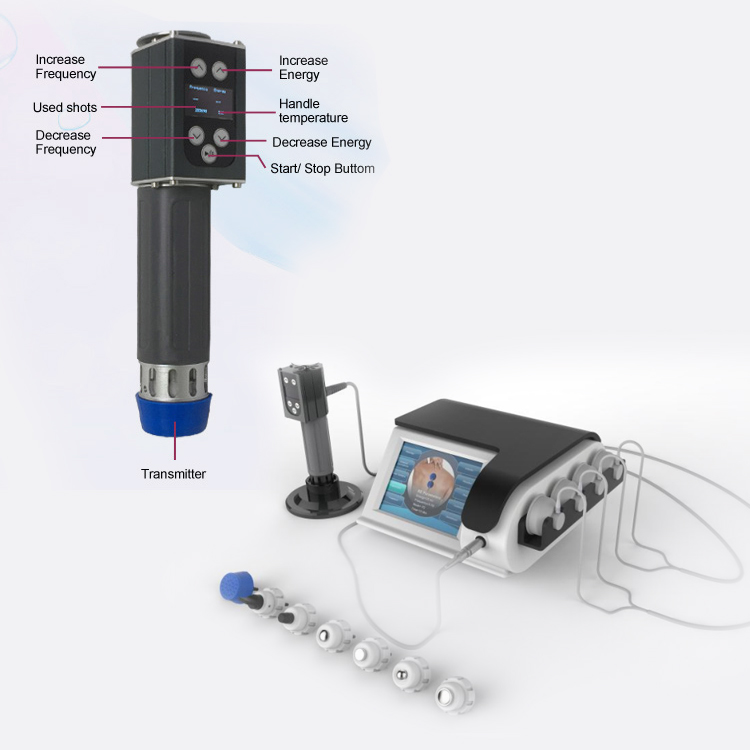Shockwave therapy is a non-invasive treatment that involves creating a series of low energy acoustic wave pulsations that are directly applied to an injury through a person’s skin via a gel medium. The concept and technology originally evolved from the discovery that focused sound waves were capable of breaking down kidney and gallstones. Generated shockwaves have proven successful in a number of scientific studies for the treatment of chronic conditions. Shockwave therapy is its own treatment for a lingering injury, or pain resulting from illness. You don’t need painkillers with it - the purpose of the therapy is to trigger the body’s own natural healing response. Many people report that their pain is reduced and mobility improved after the first treatment.
How does shockwave therapy work?
Shockwave therapy is a modality that is becoming more common in physiotherapy. Using a much lower energy than in medical applications, shockwave therapy, or extracorporeal shock wave therapy (ESWT), is used in the treatment of many musculoskeletal conditions, primarily those involving connective tissues such as ligaments and tendons.
Shockwave therapy offers physiotherapists another tool for stubborn, chronic tendinopathy. There are some tendon conditions that just don't seem to respond to traditional forms of treatment, and having the option of shockwave therapy treatment allows physiotherapist another tool in their arsenal. Shockwave therapy is most suited for people who have chronic (ie greater than six weeks) tendinopathies (commonly referred to as tendinitis) which haven't responded to other treatment; these include: tennis elbow, achilles, rotator cuff, plantar fasciitis, jumpers knee, calcific tendinitis of the shoulder. These could be as a result of sport, overuse, or repetitive strain.
You will be assessed by the physiotherapist at your first visit to confirm that you are an appropriate candidate for shockwave therapy. The physio will ensure you are educated about your condition and what you can do in conjunction with treatment - activity modification, specific exercises, assessing any other contributing issues such as posture, tightness/weakness of other muscle groups etc. Shockwave treatment is usually done once a week for 3-6 weeks, depending on results. The treatment itself can cause mild discomfort, but it only last 4-5 minutes, and the intensity can be adjusted to keep it comfortable.
Shockwave therapy has shown to effectively treat the following conditions:
Feet - heel spurs, plantar fasciitis, Achilles tendonitis
Elbow – tennis and golfers elbow
Shoulder - calcific tendinosis of rotator cuff muscles
Knee - patellar tendonitis
Hip – bursitis
Lower leg - shin splints
Upper leg - Iliotibial band friction syndrome
Back pain - lumbar and cervical spine regions and chronic muscular pain
Some of the benefits of shockwave therapy treatment:
Shockwave therapy has excellent cost/effectiveness ratio
Non-invasive solution for chronic pain in your shoulder, back, heel, knee or elbow
No anesthesia required, no drugs
Limited side effects
Main fields of application: orthopedics, rehabilitation, and sport medicine
New research shows that it can have a positive affect on acute pain
After the treatment, you may experience temporary soreness, tenderness or swelling for a few days following the procedure, as the shockwaves stimulate an inflammatory response. But this is the body healing itself naturally. So, it’s important not to take any anti-inflammatory medication after treatment, which may slow down the results.
Upon completion of your treatment you can return to most regular activities almost immediately.
Are there any side effects?
Shockwave therapy should not be used if there is a circulation or nerve disorder, infection, bone tumor, or a metabolic bone condition. Shockwave therapy should also not be used if there are any open wounds or tumors or during pregnancy pregnant. People using blood-thinning medications or who have severe circulatory disorders may also not be eligible for treatment.
What not to do after shockwave therapy?
You should avoid high impact exercise such as running or playing tennis for the first 48 hours after treatment. If you feel any discomfort, you can take paracetamol if you're able, but avoid taking a non-steroidal anti-inflammatory painkiller such as ibuprofen as it will counteract the treatment and render it useless.
Post time: Feb-15-2023

